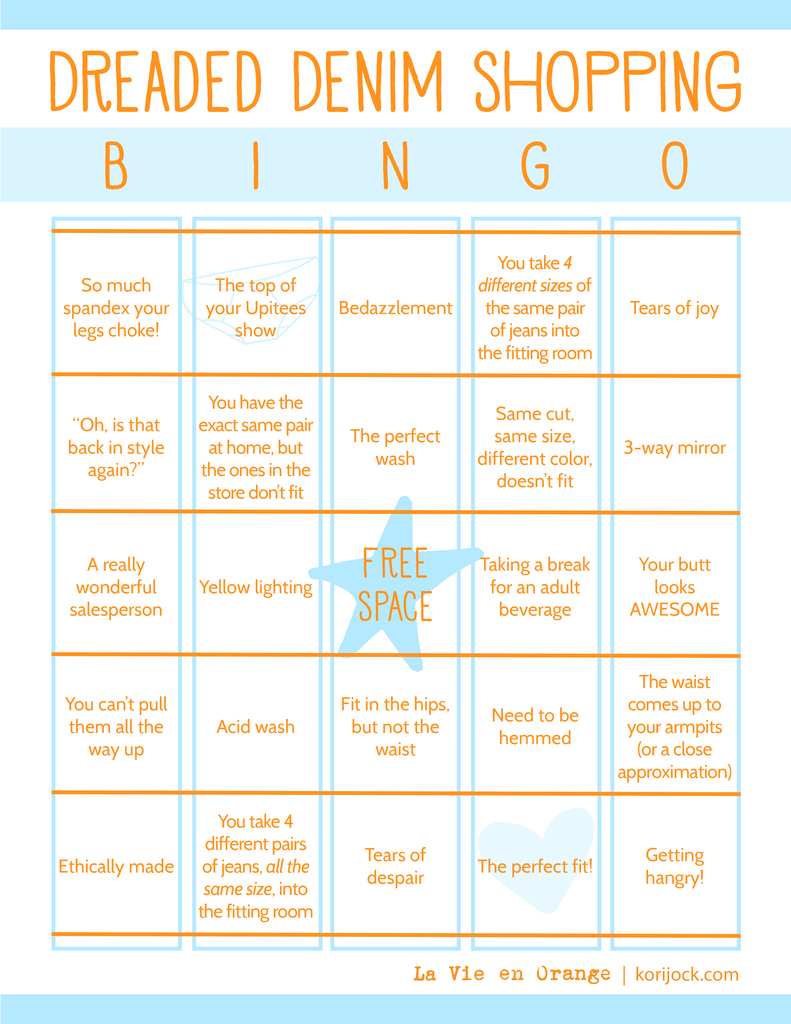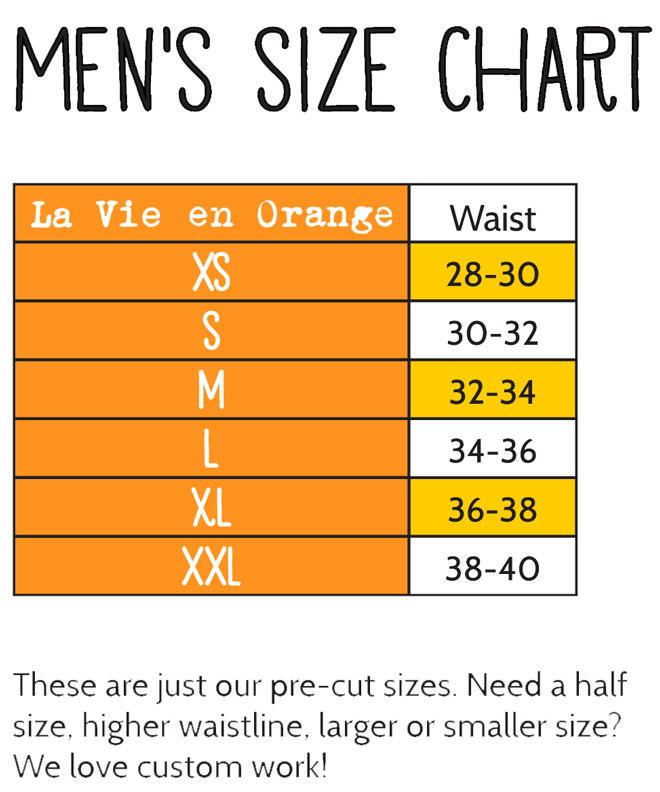[Free Download] In pursuit of happiness & perfectly fitting jeans
Your palms are sweating. You can feel the dank yellow fitting room light washing over you. You're certain there's a headache coming on. You just want it to be over already.
But you haven't even left the house yet.
It's just that you need a pair of jeans. So badly that you'll submit yourself to trying on 14,000 pairs with the hopes of finding just one that's the perfect combination of rise, length, butt to hip ratio, wash and price. There are so many jeans in the world, there's got to be one pair that will fit you, right?
By the by, it's not you. It's definitely the jeans. This 2003 study looked at 1,000 size 4 pairs of jeans and found as much as 8.5" difference in waist sizes.1 8.5 inches.
But how did we get here? Why on earth is finding a pair of jeans (or any piece of clothing, really) so flipping difficult? And is there a way out?
This week on the blog, the history of sizing (it's more interesting than you might guess), and BINGO cards to take with you the next time you go denim shopping. Because if we can't fix the sizes, at least we can make a game out of something that everyone hates ;) Living la vie en orange, and all...
From no sizes to yes sizes
Fading in: Back in the day, you were either well-enough-to-do that you had your clothes made for you, or you made your own clothes.2 And they fit well, because they were made just for you.2 Sizes didn't even exist because everything was custom.2
Sizes. Didn't. Even. Exist. Breathe that in.
Sidenote: There's a little corner of our studio where this utopia still exists. For our clients with a custom fit, there are only pattern pieces hanging with their names. No numbers whatsoever. :)
Standardized sizes weren't even a twinkle in anyone's eye until the Napoleonic Wars over in Europe (early 1800s), though there is evidence of standardized sizing for men during the Revolutionary War on this continent.3,4 With the advent of treadle sewing machines and the beginnings of mass production, soldiers' uniforms were cranked out based on men's chest sizes and what was considered "proportional" for body types back in the day. 4
Bust-Only Sizing
Which was all fine and dandy for men, for the most part, I guess. But with the increase in catalog shopping towards the second half of the 1800s and early 1900s (like we talked about last time in our history of undies post) and the move away from custom, handmade garments, standardized women's sizes were sorely needed.4 Be careful what you wish for?
Which, of course, didn't work when they tried to use chest sizes exclusively, like they did for men.4 Because bosoms don't have so much to do with the rest of your measurements.4 Hello, common sense.
And the best part is, there's even a quote in a New York Times article from 1927 with a retail exec complaining about how terrible sizes are.4 You are not alone. Our foremothers had the same gripes.
"...but average, tall, short, thin and plump women come into a department store and the 36 size fits none of them." 4
The First Study of Women's Measurements
By the 1930s, the uproar of dissatisfaction had reached the ear of the government, which funded a study to try to figure out common women's proportions.3 The ultimate goal was to create a standardized sizing system for all apparel manufacturers.4 15,000 women were measured in 59 spots on their bodies, and all this data was aggregated to create a simple system.4
Except.
The study paid its participants, so mostly lower income women signed up.4 And during that time, lower income folks were more likely to be malnourished, so the study skewed smaller than the average woman.4 And! All the participants of colors' measurements were thrown out, because racism.4
So the standard sizing system meant to solve everyone's problems was based on probably malnourished white women.4
Does that make anyone else think of runways? Thank goodness those are becoming a little bit more diverse...
The study's findings were released in 1939, and were pretty useless for manufacturers because there were so many sizes.3 27ish in total, with numbers and letters incorporating height and weight.4 Surprise! Women don't just come in 8 sizes. Also surprise! No one wants to tell a sales clerk their measurements!2
By 1958, the system was reanalyzed and another standardized system based on the classic hourglass figure with even sizes 8-38 and letters, and everything is completely arbitrary the way shoe sizes are arbitrary, but at least it's standard, right?4
Wrong. The industry started out enthusiastic, but by 1970 no one was into it anymore and by 1983, the government had totally scrapped the idea.4
Hello, Vanity Sizing
Which is when the brands were put in charge and sizing started morphing into the system we have today.2
Bodies were getting bigger, both taller, and curvier (and still are) and just like in the first half of the 1900s people were (and still are) feeling pressure to look a certain way.4 Brands started shrinking the numbers on sizes, in a move popularly called "vanity sizing."2 It's the idea that if you wear a smaller size somewhere, you'll feel better about yourself and want to shop there more.2 Which is how a 12 in 1953 is a size 6 today.2
There's a chart from the Washington Post showing just how much things have changed here. It made my eyes bug out a little bit...
But vanity sizing, or "insanity sizing" as it's sometimes called, is discriminatory and poopy.2 When most American women are over a size 14 and most American shops don't carry much above a size 16, pepole are being left behind.2 And it sucks. Even Tim Gunn thinks so. This is why LVEO offers up to size 30 for all our made-to-order goodies, but custom sizing for everyone, at any time.
Still, some industry professionals swear that vanity sizing isn't a thing, and that sizes have to shift with populations.5 It's absurd to think that we, with vitamins, and year-round fresh veggies up north, would wear the same sizes as our ancestors who didn't have refrigeration or modern nutrition.5
I know I'm a heck of a lot taller than most of the women who lived in the first half of the 1900s, and I'm grateful to be able to find pants that are long enough these days. Back in the 80s and early 90s, that wasn't a thing, and it's a big part of why I started sewing clothes.
The industry isn't a villain, they maintain.5 It's just working to meet the needs of its clients, which it has always done and will always do.5
And I think there is a morsel of truth in that. This Time article summarized it smartly (but not colorfully like me ;)): sizes are arbitrary as f*ck.2 There was never any rhyme or reason to them, and wanting rhyme and reason doesn't really get anyone anywhere either. Because we're just all shaped so so differently.2 What's really happening with sizing is that brands are getting to know their ideal clients really really well, and building their size charts around those clients exclusively.2
Finding Your Perfect Fit
So, you might never find jeans that fit at Abercrombie and Fitch, for example, (and thank goodness, let's be honest. What were you doing in there anyway?), but there is a brand out there that is making jeans just for you.
The fun(?) part is finding them.
And when you do, hold on tight. Let them know you love their fit so they don't try to change it on you. And enjoy the sweet, sweet, bliss of perfect denim.
And if we're that brand for you undies-wise, comment below, or send an email to tell us how much you love us. Your praise helps other folks not be scared to take the plunge!
The good news: You do have some tools in your tool box.
- If you're shopping online or even in person, knowing your measurements can help. Not sure where to start? We made a video about how to take them here.
- If you're shopping in person, talk to the salesperson. They'll hopefully know the brands well and how things fit and skew. It's their job.
- If you're looking for a new brand, be patient. Like we've been talking about, clothing sizes are as arbitrary as shoe sizes. So much so that LVEO has even considered not using numbers at all, but shapes. But that seems like it would be even harder... ;) Let your mantra be, "Clothing sizes are bunk."
- Take snacks or a flask, or whatever you need to make it through the ordeal, but especially, take these denim shopping BINGO cards we made. Because laughing is better than crying. There are a few different versions in case you go out with friends.
And have fun. Because fun is always better than not-fun.
At the very least, bask in the glow of knowing your undies will always fit. It's our Hot Booty Guarantee.
xoxo
Sources:
1 - Kinley, Tammy R. "Size Variation in Women's Pants." Clothing and Textiles Research Journal. Vol. https://www.researchgate.net/publication/247783680_Size_Variation_in_Women's_Pants
2 - Dockterman, Eliana. "One Size Fits None: Inside the Fight to Take Back the Fitting Room." Time. http://time.com/how-to-fix-vanity-sizing/
3 - VOX. "Why Women's Clothing Sizes Don't Make Sense." 3 Aug. 2016. YouTube, https://www.youtube.com/watch?v=7QwlT5f7H1c
4 - Felsenthal, Julia. "A Size 2 Is a Size 2 Is a Size 8: Why clothing sizes make no sense." Slate. 25 Jan. 2012. http://www.slate.com/articles/arts/design/2012/01/clothing_sizes_getting_bigger_why_our_sizing_system_makes_no_sense_.html
5 - Fasanella, Kathleen. "Vanity sizing: generational edition." Fashion-Incubator. 12 June 2008. http://fashion-incubator.com/vanity_sizing_generational_edition/







